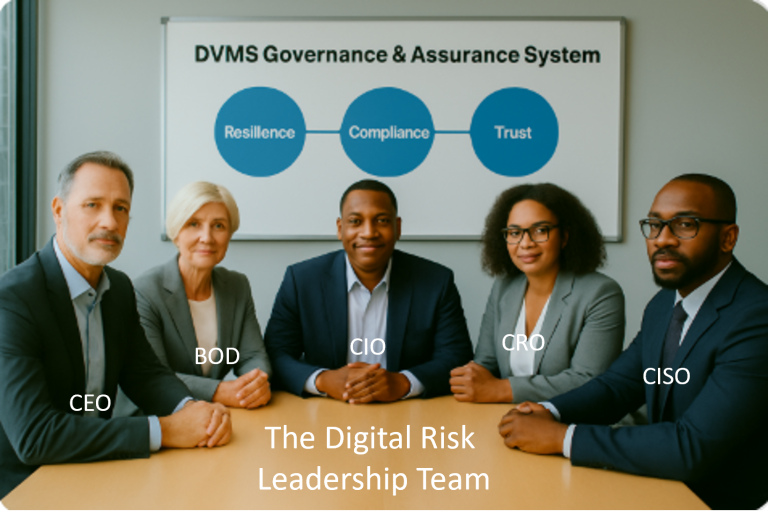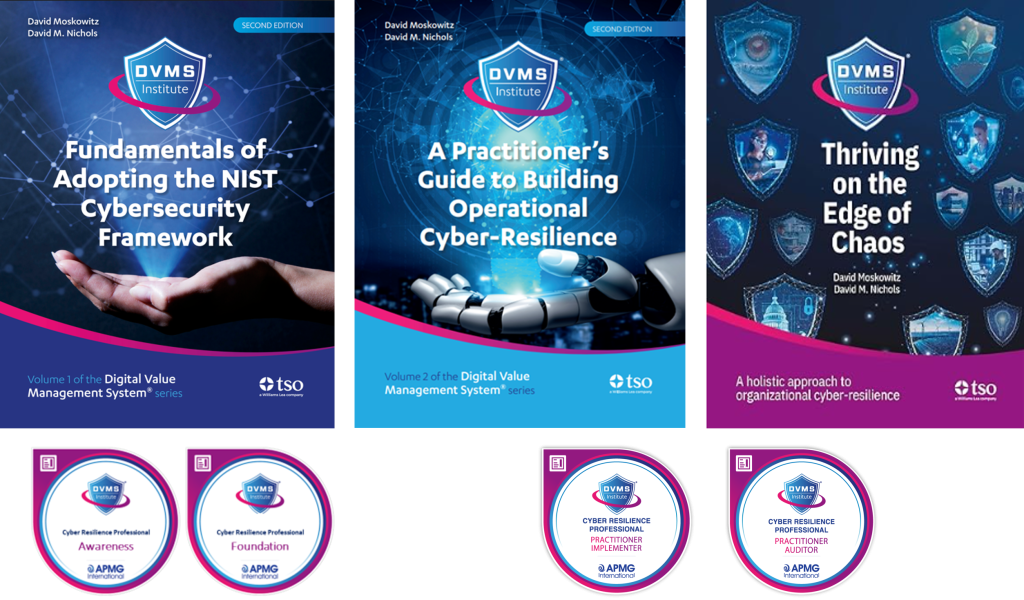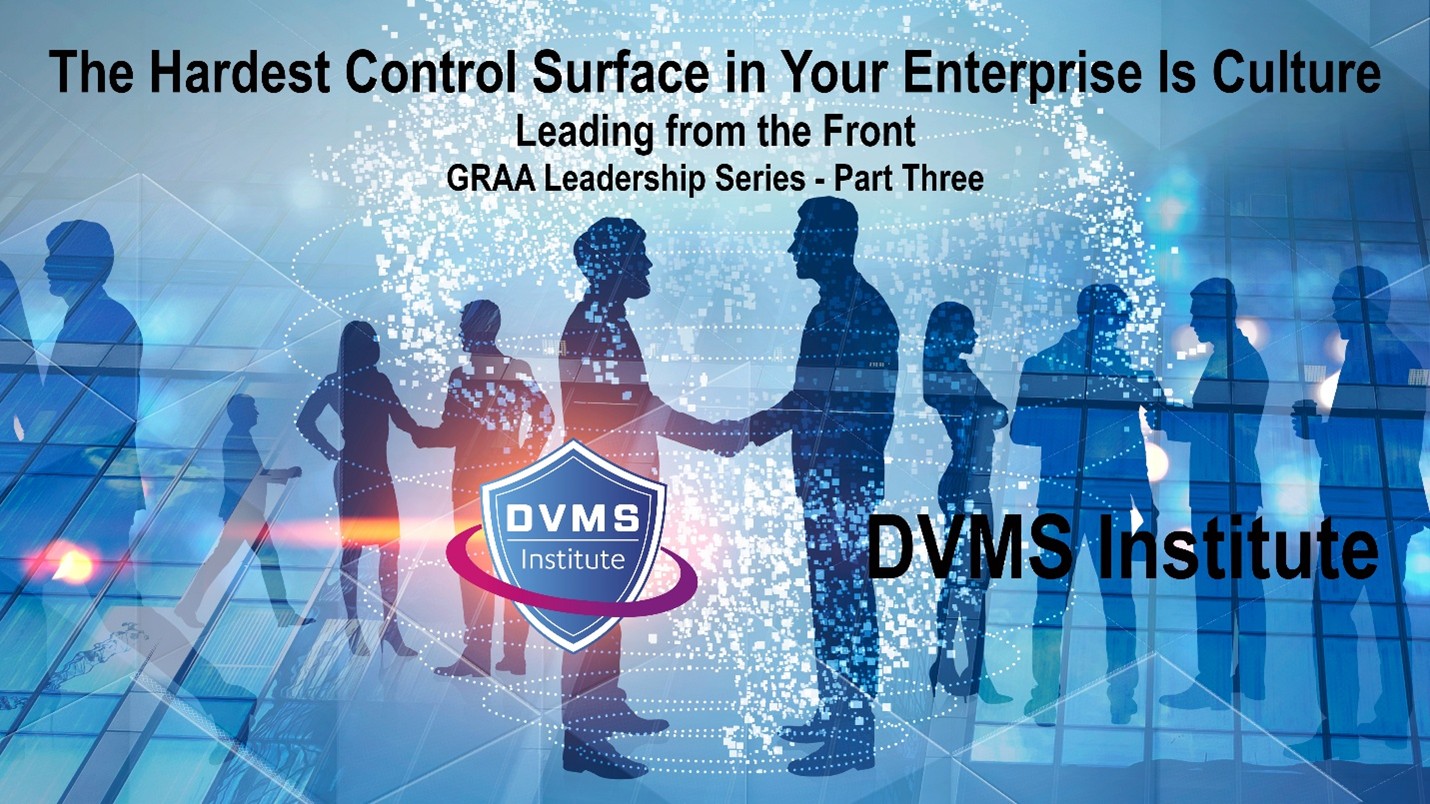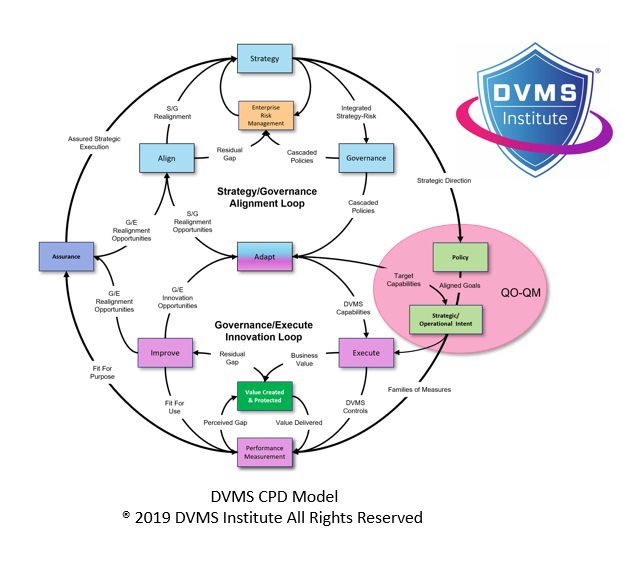The Digital Leadership Imperative: Evolve Governance and Assurance to Ensure Resilience, Compliance, and Trust
Rick Lemieux – Co-Founder and Chief Product Officer of the DVMS Institute
Introduction
In today’s digital economy, organizations face a relentless pace of disruption. Emerging technologies, cyber threats, regulatory complexity, and shifting market dynamics have made digital business both an enabler of growth and a source of systemic risk. The traditional approach—treating governance, risk, and compliance as separate, control-based functions—is no longer sufficient. Businesses now require a systematic, evidence-based approach that integrates governance, assurance, risk, and resilience into a single operational model, capable of adapting in real-time.
A Digital Value Management System® (DVMS) meets this need. It is a unified governance and assurance system that drives resilient, compliant, and trusted digital business operations amid continuous digital disruption. Unlike frameworks that prescribe what to do or tools that automate tasks, the DVMS functions as an overlay management system that connects the dots between governance intent, operational execution, and performance assurance. It transforms digital governance from a static compliance exercise into a dynamic system of value creation and trust assurance.
The Essence of a Digital Value Management System®
At its core, the DVMS is built to ensure that an organization’s digital ecosystem—its technologies, data, processes, and people—operates in alignment with its strategic objectives. It integrates existing frameworks, such as the NIST Cybersecurity Framework (CSF), ISO standards, and COBIT, into a continuous value and assurance loop.
Through this integration, the DVMS provides three key capabilities:
- Governance Alignment – ensuring digital operations are managed in accordance with enterprise objectives and stakeholder expectations.
- Operational Resilience – embedding risk and resilience practices directly into the flow of operations, enabling systems to anticipate, absorb, and adapt to disruption.
- Continuous Assurance – providing evidence-based visibility into the integrity, performance, and trustworthiness of digital operations.
This combination enables leaders to manage not only for compliance, but also for performance and trust—transforming governance and assurance into engines of innovation rather than constraints.
For the CEO: Turning Governance into a Strategic Advantage
For the Chief Executive Officer, the DVMS provides a clear line of sight between digital operations, business performance, and strategic outcomes. In most organizations, governance and resilience are often viewed as overhead—necessary yet disconnected from growth initiatives. The DVMS changes that equation by creating a value chain of accountability that ties every digital activity to enterprise outcomes.
This means CEOs can now see, in measurable terms, how digital investments contribute to resilience, efficiency, and customer trust. The system enables strategic decision-making based on reliable, real-time assurance rather than after-the-fact reports. With this visibility, governance becomes a strategic enabler—a mechanism for driving sustainable growth, managing uncertainty, and maintaining stakeholder confidence even during disruption.
Ultimately, the DVMS empowers the CEO to govern by evidence rather than assumption, shifting governance from a defensive posture to a proactive driver of competitiveness and innovation.
For the Board: Evidence-Based Assurance and Stakeholder Trust
For the Board of Directors, the DVMS delivers what governance bodies have long needed but rarely achieved—continuous, evidence-based assurance. Traditional board reporting is static and periodic, often reliant on self-attestation or fragmented metrics from disparate departments. The DVMS replaces this with real-time governance intelligence that links operational integrity directly to enterprise value.
Through its integrated structure, the DVMS enables directors to oversee not only compliance and risk but also the resilience and trustworthiness of digital operations across the business ecosystem. It ensures that digital assets are protected, operations are robust, and the organization’s digital behavior aligns with regulatory and ethical expectations.
In a business environment where stakeholder trust is currency, the DVMS becomes the Board’s assurance backbone. It provides a defensible, data-driven narrative that connects digital performance to shareholder value, regulatory accountability, and brand reputation.
For the CIO: Aligning Technology with Measurable Business Value
For the Chief Information Officer, the DVMS provides the structure to bridge a long-standing gap—aligning technology operations and investments with measurable business outcomes. CIOs often struggle to demonstrate how digital transformation initiatives contribute to enterprise performance. The DVMS addresses this by establishing a governance system of record that links digital initiatives, risks, and performance indicators to business value.
Through the DVMS, the CIO gains a governance mechanism that integrates IT, cybersecurity, and business operations under a unified performance model. It ensures that every investment in technology can be justified through its contribution to resilience, efficiency, and stakeholder trust.
By operationalizing governance through the DVMS, CIOs can manage complexity with clarity—balancing innovation with risk, agility with control, and cost with value. It provides a practical foundation for data-driven decision-making, where technology is no longer just an enabler but a governed driver of enterprise performance.
For the CRO: Turning Risk into a Driver of Adaptability
For the Chief Risk Officer, the DVMS embeds risk and resilience directly into operational processes. Traditionally, risk management has been viewed as a defensive function focused on identifying and mitigating threats. The DVMS transforms this into a strategic, performance-oriented capability.
Within a DVMS, risk management is not an afterthought—it’s a design principle. The system ensures that risk awareness, resilience planning, and performance measurement operate as an integrated cycle. This enables organizations to anticipate disruption, respond effectively, and adapt continuously without compromising business integrity or strategic focus.
For the CRO, this means risk becomes a dynamic input to innovation. Instead of limiting opportunity, risk intelligence drives smarter decisions, operational learning, and continuous improvement. The DVMS enables a shift from reactive risk reporting to proactive resilience leadership, where risk is understood, managed, and leveraged as a catalyst for enterprise adaptability.
For the CISO: Demonstrating Continuous Cyber Resilience and Digital Trust
For the Chief Information Security Officer, the DVMS provides a continuous assurance mechanism that demonstrates cyber resilience and digital trust across the enterprise and its supply chain. In an era of constant cyber threats and complex regulatory expectations, CISOs face pressure not only to secure systems but also to prove resilience in measurable, auditable ways.
The DVMS enables this by integrating cybersecurity, risk, and assurance activities into a single, evidence-based governance system. It connects security controls and performance metrics directly to business objectives, providing visibility into how cybersecurity contributes to operational continuity and trust.
With the DVMS, the CISO can move from “managing controls” to governing outcomes. Security becomes an enabler of trust rather than a barrier to innovation. The system also enhances collaboration between IT, risk, and business units—ensuring that resilience is a shared responsibility rather than a siloed function.
In short, the DVMS enables the CISO to deliver on the ultimate promise of cybersecurity: not just protection but assured digital trust and operational confidence.
For Internal and External Auditors: Demonstrating Continuous Digital Business Operations Under Stress
For internal and external auditors, a Digital Value Management System (DVMS) provides a unified, evidence-based framework that transforms governance, risk, and compliance into a continuous assurance system. By integrating frameworks such as NIST, ISO, and COBIT, the DVMS links governance intent with operational execution and measurable performance outcomes. This allows auditors to move beyond static checklists and point-in-time attestations, gaining real-time visibility into whether controls are not only present but effective under stress. Through continuous assurance loops, the DVMS supplies verifiable, data-driven evidence that demonstrates the organization’s ability to sustain operations, protect stakeholder value, and maintain regulatory confidence even amid disruption
Building a Culture of Trusted Digital Performance
The power of the DVMS extends beyond processes and metrics—it lies in creating a culture of trust, accountability, and continuous improvement. In many organizations, governance and risk are treated as compliance obligations. The DVMS reframes them as cultural drivers of excellence.
Institutionalizing evidence-based governance encourages every function to understand its role in sustaining digital value. Teams are empowered to act with clarity, knowing how their work contributes to business resilience and customer trust. Over time, this builds what can be described as a culture of assured performance—where governance is not imposed from above but lived across the enterprise.
The Path Forward
In an environment defined by uncertainty, the Digital Value Management System® offers a clear, actionable path to sustainable digital success. It unites governance, resilience, and assurance in a way that not only safeguards the enterprise but also drives performance, adaptability, and innovation.
For CEOs and Boards, it provides confidence that digital investments are aligned with strategic outcomes. For CIOs, CROs, and CISOs, it operationalizes governance and resilience as measurable, continuous capabilities. And for the organization, it establishes the trust foundation on which digital business performance can thrive.
In essence, the DVMS represents the next evolution of digital governance—a shift from managing for control to governing for confidence, resilience, and value. It transforms governance from a burden into a strategic advantage—ensuring that in the face of continuous disruption, organizations don’t just survive, but continuously evolve, improve, and lead.
About the Author

Rick Lemieux
Co-Founder and Chief Product Officer of the DVMS Institute
Rick has 40+ years of passion and experience creating solutions to give organizations a competitive edge in their service markets. In 2015, Rick was identified as one of the top five IT Entrepreneurs in the State of Rhode Island by the TECH 10 awards for developing innovative training and mentoring solutions for boards, senior executives, and operational stakeholders.
Digital Value Management System® (DVMS)
The DVMS is an adaptive, culture-enabled governance overlay designed to help organizations of any size, scale, or complexity transition from static, paper-based governance models to a living, evidence-based system of Governance, Resilience, Assurance, and Accountability (GRAA).
At its core, the DVMS is a simple but powerful integration of:
-
Governance Intent – shared expectations and accountabilities.
-
Operational Capability – how the business actually performs
-
Assurance Evidence – proof that intended outcomes are being achieved
Rather than adding more complexity, a DVMS integrates fragmented frameworks and practices such as NIST CSF, GRC, ITSM, DevOps, and AI into a unified overlay system that enables leaders and regulators to see, in real time, whether the digital business is working as intended—and whether the risks that matter most are being managed proactively.
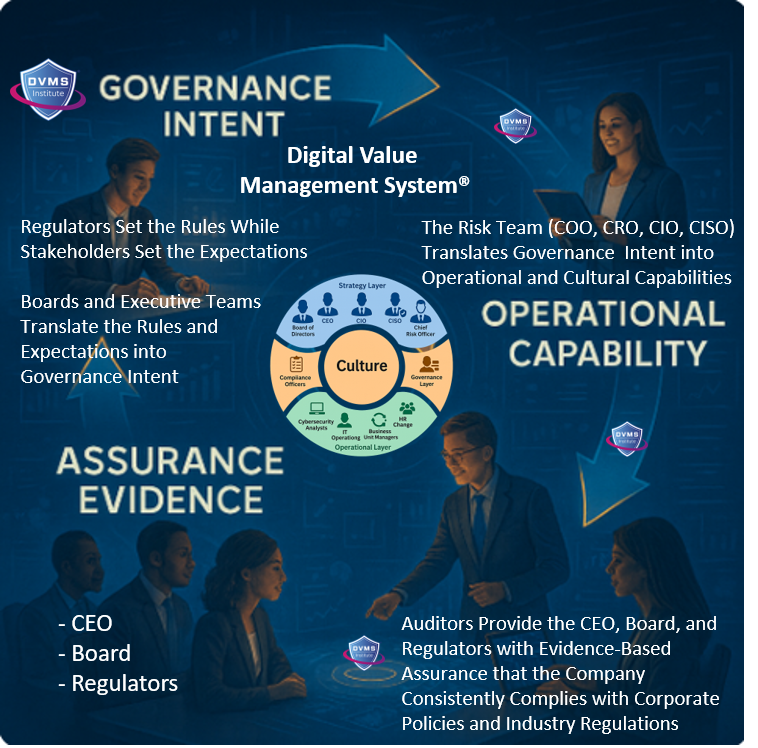
Through its MVC, CPD, 3D Knowledge, and FastTrack Models, a DVMS turns this integration into three distinctive capabilities:
A Governance Overlay that replaces fragmentation with unity. The DVMS provides organizations with a structured way to connect strategy with day-to-day execution. Leaders gain a consistent mechanism to direct, measure, and validate performance—across every system responsible for digital value.
A Behavioral Engine that drives high-trust, high-velocity decision-making. The DVMS embeds decision models and behavioral patterns that help teams think clearly and act confidently, even in uncertain situations. It is engineered to reduce friction, prevent blame-based cultures, and strengthen organizational reliability.
A Learning System that makes culture measurable, adaptable, and scalable. Culture becomes a managed asset—not an abstract concept. The DVMS provides a repeatable way to observe behavior, collect evidence, learn from outcomes, and evolve faster than threats, disruptions, or market shifts.
DVMS Organizational Benefits
Instead of replacing existing operational frameworks, the DVMS elevates them—connecting and contextualizing their data into actionable intelligence that validates performance and exposes the reasons behind unmet outcomes.
By adopting a DVMS, organizations are positioned to:
- Maintain Operational Stability Amidst Constant Digital Disruption
- Deliver Digital Value and Trust Across A Digital Ecosystem
- Satisfy Critical Regulatory and Certification Requirements
- Leverage Cyber Resilience as a Competitive Advantage
DVMS Leadership Benefits
The Digital Value Management System (DVMS) provides leaders with a unified, evidence-based approach to governing and enhancing their digital enterprise, aligning with regulatory requirements and stakeholder expectations.
For the CEO, the DVMS provides a clear line of sight between digital operations, business performance, and strategic outcomes—turning governance and resilience into enablers of growth and innovation rather than cost centers.
For the Board of Directors, the DVMS provides ongoing assurance that the organization’s digital assets, operations, and ecosystem are governed, protected, and resilient—supported by evidence-based reporting that directly links operational integrity to enterprise value and stakeholder trust.
For the CIO, CRO, CISO, and Auditors: an integrated, adaptive, and culture-driven governance and assurance management system that enhances digital business performance, resilience, trust, and accountability
DVMS White Papers
The three whitepapers below present a coherent progression that shifts organizations from compliance-driven thinking to a modern system of Governance, Resilience, Assurance, and Accountability (GRAA). Collectively, the three papers define a comprehensive system for building and governing resilient digital enterprises, grounded in evidence rather than assumptions.
The Assurance Mandate Paper sets the stage by showing why traditional GRC artifacts provide only reassurance—not evidence—and calls boards to demand forward-looking proof that their organizations can continue to create, protect, and deliver value under stress.
The Assurance in Action Paper elevates the conversation from leadership intent to managerial execution, demonstrating how the DVMS operationalizes resilience by translating outcomes into Minimum Viable Capabilities, connecting frameworks through the Create–Protect–Deliver model, and generating measurable assurance evidence that managers can use to demonstrate real performance rather than activity.
The Governing by Assurance Paper elevates the approach to the policy and regulatory level, showing how DVMS functions as a learning overlay system that links governance intent, operational capability, and verifiable evidence into a continuous loop—enabling regulators, agencies, and enterprises to govern by outcomes rather than checklists and to prove capability with measurable, auditable performance data.
DVMS Cyber Resilience Certified Training Programs
DVMS Cyber Resilience Awareness Training
The DVMS Cyber Resilience Awareness course and its accompanying body of knowledge publication educate all employees on the fundamentals of digital business, its associated risks, the NIST Cybersecurity Framework, and their role within a shared model of governance, resilience, assurance, and accountability for creating, protecting, and delivering digital value.
This investment fosters a culture that is prepared to operate within a system capable of transforming systemic cyber risks into operational resilience.
DVMS NISTCSF Foundation Certification Training
The DVMS NISTCSF Foundation certification training course and its accompanying body of knowledge publications provide ITSM, GRC, Cybersecurity, and Business professionals with a detailed understanding of the NIST Cybersecurity Framework and its role in a shared model of governance, resilience, assurance, and accountability for creating, protecting, and delivering digital value.
This investment fosters IT, GRC, Cybersecurity, and Business professionals with the skills to operate within a system capable of transforming systemic cyber risks into operational resilience.
DVMS Cyber Resilience Practitioner Certification Training
The DVMS Practitioner certification training course and its accompanying body of knowledge publications teach ITSM, GRC, Cybersecurity, and Business practitioners how to elevate investments in ITSM, GRC, Cybersecurity, and AI business systems by integrating them into a unified governance, resilience, assurance, and accountability system designed to proactively identify and mitigate the cyber risks that could disrupt operations, erode resilience, or diminish client trust.
This investment fosters IT, GRC, Cybersecurity, and Business practitioners with the skills to assess, design, implement, operationalize, and continually innovate a Digital Value Management System® program that operationalizes a shared model of governance, resilience, assurance, and accountability for creating, protecting, and delivering digital value.
Company Brochures and Presentation
Explainer Videos
- DVMS Architecture Video: David Moskowitz explains the DVMS System
- DVMS Case Study Video: Dr. Joseph Baugh Shares His DVMS Story.
- DVMS Overlay Model – What is an Overlay Model
- DVMS MVC ZX Model – Powers the CPD
- DVMS CPD Model – Powers DVMS Operations
- DVMS 3D Knowledge Model – Powers the DVMS Culture
- DVMS FastTrack Model – Enables A Phased DVMS Adoption
Digital Value Management System® is a registered trademark of the DVMS Institute LLC.
® DVMS Institute 2025 All Rights Reserved

